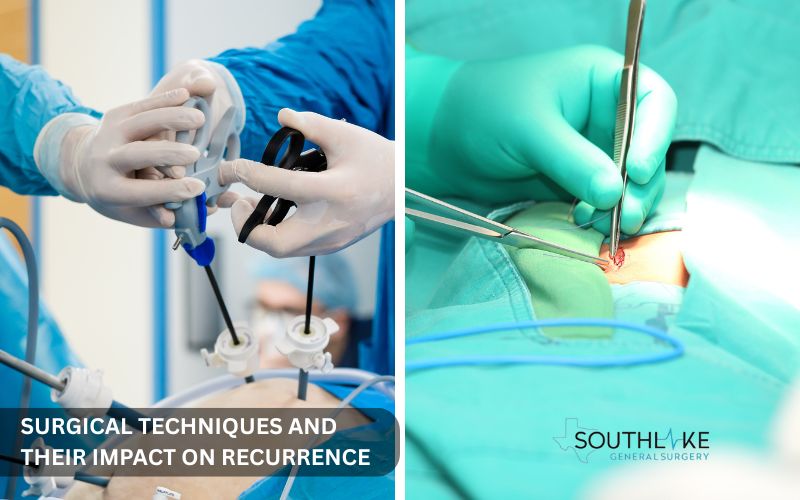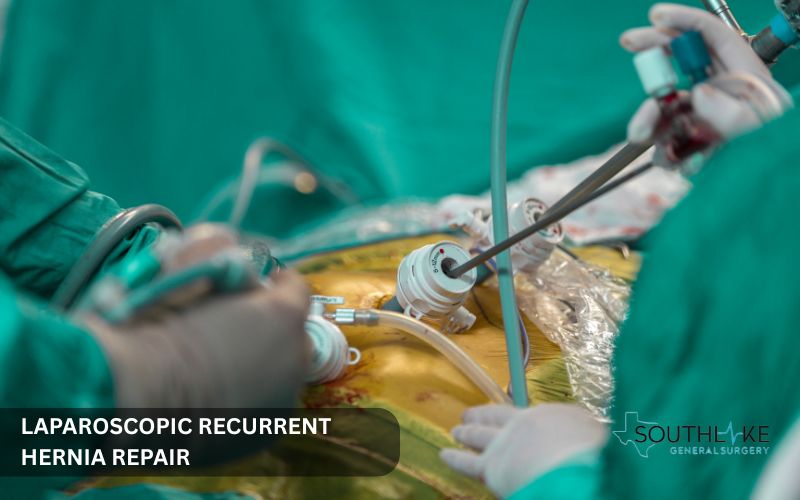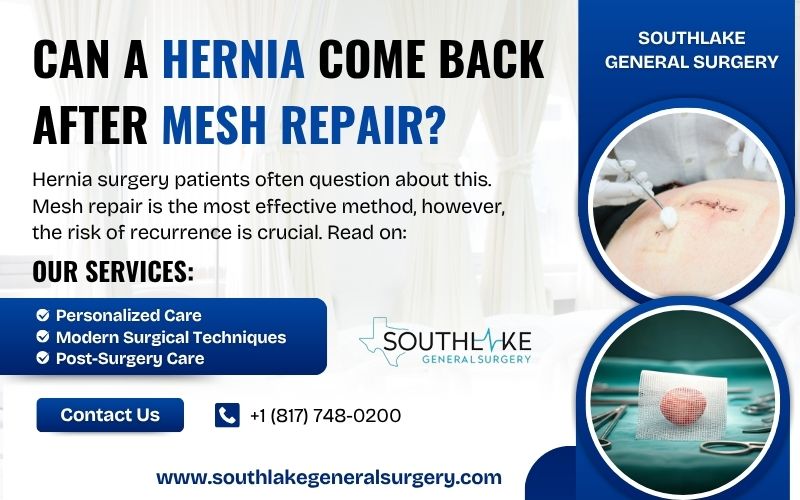Can a hernia come back after mesh repair? Many patients wonder about this after hernia surgery. While mesh repair is the gold standard for effectiveness, understanding recurrence potential is vital for informed choices.
Recurrence of hernias is significantly less likely when mesh is used instead of more traditional methods. However, factors such as the type of mesh, surgical technique, and the patient’s overall health influence recurrence rates.
Key Highlights
- Compared to non-mesh procedures, mesh hernia surgery greatly reduces the chance of hernia recurrence.
- Factors such as the type of mesh used, how the surgery is performed, and a patient’s health can impact recurrence rates.
- People who have emergency surgery or their first surgery without mesh are at a higher risk of recurrent hernias.
- Laparoscopic repair might have slightly higher rates of recurrence than open repair, but it helps patients recover faster.
- After surgery, taking care with a balanced diet and steering clear of strenuous physical activity can help reduce the risk of recurrence.
- Skilled surgeons, like Dr. Valeria Simone, MD, use modern methods to reduce recurrence and complications.
Understanding Hernia and Mesh Repair
Internal organs can cause hernias when they protrude through a vulnerable area in the abdominal wall. This can cause pain and other issues. Doctors often recommend mesh hernia repair. This approach fortifies the vulnerable region and minimizes the possibility of recurrence. It also helps control the way the organ pushes through that area.
The mesh works like a wall. It keeps the herniated tissue protected and strengthens the area around it. Surgical methods have improved over time. Today, there are less invasive options that leave smaller scars and help people heal more quickly. However, some patients still have recurrences. This is why it’s important to examine hernias more closely.
What is a Hernia?

A hernia occurs when tissues or organs push through a weak spot in the abdominal wall. There are several kinds of hernias, and they are often named for their location. Inguinal hernias, which manifest in the groin area, are quite common. Another type is known as the incisional hernia, which develops at sites where surgical procedures have occurred.
People with hernias usually notice a bulge or feel discomfort and swelling in their abdomen, groin, or testicles. These bulges can feel worse when standing or straining. If you ignore a hernia, it could lead to serious problems, like blocking or strangling internal organs.
For a lot of people, surgery is needed to fix a hernia. This is particularly the case if they feel pain or if the hernia becomes bigger. The FDA states that using mesh for repairs is very common now. It can help lower the chances of the hernia coming back. It is important to know about the anatomy and types of hernias. This information helps in making the right treatments for each person.
How is Mesh Used in Hernia Repairs?
Surgical mesh is important for reducing the risk of hernias coming back after they are fixed. This mesh provides reinforcement for the vulnerable region of the abdominal wall.
Hernia repair using mesh can be done in two ways:
- Laparoscopic surgery uses less invasive techniques.
- Open surgery is the old-fashioned method.
In laparoscopic hernia repair, doctors use a tiny video camera and surgical tools. This helps them place the mesh exactly where it is needed.
Using advanced mesh can lower recurrence rates when compared to repairs without mesh. It also helps you recover faster. However, the rates of recurrence can change depending on the type of mesh used and the surgery method. So, what factors affect these recurrence rates?
Factors Influencing Hernia Recurrence After Mesh Repair
Hernia recurrence after mesh repair can happen depending on several important factors. These factors include the type of mesh used, the method of surgery, the patient’s health, and any bowel complications. In general, synthetic meshes are stronger and last longer than others. Still, in some situations, biological meshes could be a better option.
Emergency surgeries done by less skilled surgeons usually lead to higher rates of hernia recurrence compared to planned surgeries. Patients with health issues, like obesity or other unmanaged problems, face a greater risk of recurrence as well. Now, let’s explore how various mesh types and surgical techniques influence the risk of hernia recurrence.
Types of Mesh and Their Effectiveness
Choosing the right surgical mesh is essential for a successful hernia repair. Here are the main points about the different types of mesh and how they perform:
- Synthetic Mesh: Most doctors pick synthetic mesh. It is robust and exhibits reduced recurrence rates in comparison to biological mesh.
- Material Composition: Choosing the right material determines how effective the mesh will be. Some mesh types are meant to last, while others are made to be absorbed by the body.
- Permanent Synthetic Mesh: These usually work better at keeping abdominal tissue strong over time.
- Recurrence Risks: The risk of hernia recurrence is higher if mesh repairs are not done or if the wrong mesh type is used. Sometimes, antibiotics are needed to treat infections after surgery.
- Advancements in Mesh Technology: New technology allows surgeons to change how they operate. This helps lower risks and improve recovery times.
- Surgeon’s Skill: A good mesh repair also relies a lot on the surgeon’s skill, which we will look into more later.
Surgical Techniques and Their Impact on Recurrence

The kind of surgery you choose can really affect the chances of a hernia coming back. Consider the following important aspects:
Surgical Approach:
- Open hernia repair has a lower chance of coming back than laparoscopic surgery. This holds particularly true for complicated hernia cases.
- In open hernia repair, the mesh is positioned, and the tissue is secured via a single large incision created by the surgeon.
- Laparoscopic surgery uses smaller cuts and a tiny video camera for the repair. While this method can allow for quicker recovery and smaller scars, it may have a slightly higher risk of recurrence compared to open repairs.
Surgeon Expertise:
- Another crucial factor is the surgeon’s proficiency. Surgeons who have special training usually have much lower recurrence rates than those without expertise.
Using the right method is key to a successful hernia repair. This matters both for treating and preventing hernias.
Role of Patient Health in Hernia Surgery Outcomes
A patient’s health plays a major role in the success of hernia repair surgery. It can also affect how likely it is that the hernia will recur. Problems like obesity or chronic illnesses can hinder recovery and raise the risks involved.
Good planning before hernia surgery is very important. It should consider the patient’s health problems. Following care instructions after the surgery can help a lot too. Let’s look at how different health issues and patient care can impact hernia surgery.
How Pre-existing Conditions Affect Hernia Surgery
Certain health issues may elevate the risks associated with hernia surgery at various stages: before, during, and following the operation. Key factors include:
- Obesity: It adds more stress to the abdominal muscles. This can make surgery harder and raise the chance of hernia recurrence.
- Diabetes: It can slow down healing after surgery.
- Deep vein thrombosis: This can lead to issues during recovery. It increases the risk of infection or makes it hard to move.
Ignoring these health issues can result in needing emergency surgery. This could lead to results that are not very good.
Taking care of health problems with the right treatments, medicines, or diet changes can improve the outcomes of surgery. A patient’s general health is very important for the success of mesh hernia repair. It also has the potential to reduce the risk of hernia recurrence.
Importance of Post-Surgery Care for Patients

Post-surgery care is very important after hernia repair. Patients should keep these points in mind during their recovery:
- Avoid intense physical activities, like lifting heavy things.
- Have a balanced diet and drink plenty of water to help your abdominal muscles heal.
- Do light exercises, such as walking, to increase blood flow and reduce the risk of deep vein thrombosis (DVT).
- No matter how little the swelling, if you detect any indications of infection, you should see a doctor immediately.
Good patient care includes:
- Attend your follow-up appointments with the surgeon as scheduled.
- Stick to the recovery instructions provided by the healthcare team.
After surgery, using these good practices can lower the risk of recurrence. This contributes to the positive results of hernia repairs moving forward.
Treatment
Surgery is the main way to fix hernias. This is especially important when symptoms get worse, or risks increase. When hernias come back, doctors might need to use more advanced methods. These consist of traditional surgical methods or minimally invasive techniques.
The method you pick depends on your first surgery and your unique situation. The goal is to repair incisional hernias and strengthen weak spots to stop them from returning. Let’s delve into the ways laparoscopic and open surgeries can successfully address recurrent hernias.
Laparoscopic recurrent hernia repair

Laparoscopy is a simpler way to treat recurrent hernias. In this procedure, surgeons create small cuts in the skin. They use special tools with cameras attached. This method allows them to access the problem area without harming any old scar tissue.
This method usually works better for fixing hernias. Hernias that develop following prior open procedures respond very well to this treatment. Patients generally heal faster, and they have fewer issues like big scars. This happens because the surgery is smaller.
The laparoscopic procedure enables surgeons to reach inaccessible parts of the abdominal wall for repair. Its success really relies on the location of the hernia. In more complicated situations, open repair might be a better choice. We will discuss that next.
Open recurrent hernia repair
If your recurring hernia is severe or complicated, your best option for treatment is open surgery. This method lets the surgeon reach the affected area directly by making a larger cut.
When a hernia comes back after laparoscopic surgery, open repair can be a helpful choice for treating scar tissue. This way, it carefully addresses the damaged areas. This reduces the risk of harming organs or putting pressure on nerves.
Open surgery might take longer to recover from compared to laparoscopic surgery. Still, it has high success rates. This makes it an important option for treating serious problems that keep coming back. When deciding between open and laparoscopic repair, it should depend on your surgical history and what goals you have.
Conclusion
In short, mesh repair is a strong way to treat hernias. It can significantly reduce the risk of the hernia recurring. However, there is a small risk involved. The success of the repair depends on several things, like the type of mesh used, how the surgery is done, and the patient’s overall health.
To get the best results, you need to follow the care instructions after surgery. It’s beneficial to discuss any changes or symptoms you observe with your healthcare provider. If you need answers about hernia repair or specific advice, contact Dr. Valeria Simone at Southlake General Surgery. She provides specialized assistance and guidance for your healing journey.
Make an Appointment
Consulting a specialist is key to getting good results after hernia repair surgery. Dr. Valeria Simone, MD, at Southlake General Surgery in Texas, can help you with expert evaluation and treatment that meet your needs.
If you are worried about hernia recurrence or complications, or if you need further treatment, you can benefit from her strong experience with both laparoscopic and open hernia repair. To make an appointment, just call her office at +1 (817) 748-0200. This is the first step towards better patient care and recovery.
Frequently Asked Questions
What are the signs that a hernia might have recurred after mesh repair?
Possible signs that a hernia may come back are lasting discomfort, a visible bulge at the surgical site, swelling, or difficulty using your abdominal muscles. You should also watch for other symptoms like constipation, nausea, or vomiting. If you see any of these signs, reach out to your healthcare provider right away.
What is the typical recovery time following hernia mesh repair surgery?
Recovery times for hernia repair surgery, including laparoscopic hernia surgery, usually take from a few days to several weeks. This time can change based on how complex the surgery is. Slowly returning to light activities, like walking, can build strength in your abdominal muscles. Good patient care is important. It can help you heal faster and lower the chance of complications during recovery.
What is the success rate of mesh repair in avoiding hernia recurrence?
Mesh repair is highly effective in preventing hernia recurrence, with studies showing success rates exceeding 90%. However, the hernia type and the patient’s overall health are two variables that could affect the specific results. Consulting a healthcare professional can provide personalized insights into the effectiveness of mesh repair for your situation.
Medically Reviewed By: Dr. Valeria Simone MD
Board-certified General Surgeon at Southlake General Surgery, Texas, USA.
Follow us on Facebook and YouTube.
References:
- Howard, R., Thumma, J., Ehlers, A., Englesbe, M., Dimick, J., & Telem, D. (2022b). Reoperation for recurrence up to 10 years after hernia repair. JAMA, 327(9), 872. https://doi.org/10.1001/jama.2022.0744
- Kokotovic, D., Bisgaard, T., & Helgstrand, F. (2016b). Long-term recurrence and complications associated with elective incisional hernia repair. JAMA, 316(15), 1575. https://doi.org/10.1001/jama.2016.15217
- Liang, M. K., Holihan, J. L., Itani, K., Alawadi, Z. M., Gonzalez, J. R. F., Askenasy, E. P., Ballecer, C., Chong, H. S., Goldblatt, M. I., Greenberg, J. A., Harvin, J. A., Keith, J. N., Martindale, R. G., Orenstein, S., Richmond, B., Roth, J. S., Szotek, P., Towfigh, S., Tsuda, S., . . . Berger, D. H. (2016). Ventral Hernia Management. Annals of Surgery, 265(1), 80–89. https://doi.org/10.1097/sla.0000000000001701
- Flum, D. R., Horvath, K., & Koepsell, T. (2003). Have outcomes of incisional hernia repair improved with time? Annals of Surgery, 237(1), 129–135. https://doi.org/10.1097/00000658-200301000-00018
- Helgstrand, F., Rosenberg, J., Kehlet, H., Strandfelt, P., & Bisgaard, T. (2012). Reoperation versus clinical recurrence rate after ventral hernia repair. Annals of Surgery, 256(6), 955–958. https://doi.org/10.1097/sla.0b013e318254f5b9
- Eker, H. H., Hansson, B. M. E., Buunen, M., Janssen, I. M. C., Pierik, R. E. G. J. M., Hop, W. C., Bonjer, H. J., Jeekel, J., & Lange, J. F. (2013). Laparoscopic vs Open Incisional Hernia Repair. JAMA Surgery, 148(3), 259. https://doi.org/10.1001/jamasurg.2013.1466
- Itani, K. M. F., Hur, K., Kim, L. T., Anthony, T., Berger, D. H., Reda, D., & Neumayer, L. (2010). Comparison of laparoscopic and open repair with mesh for the treatment of ventral incisional hernia. Archives of Surgery, 145(4), 322. https://doi.org/10.1001/archsurg.2010.18

